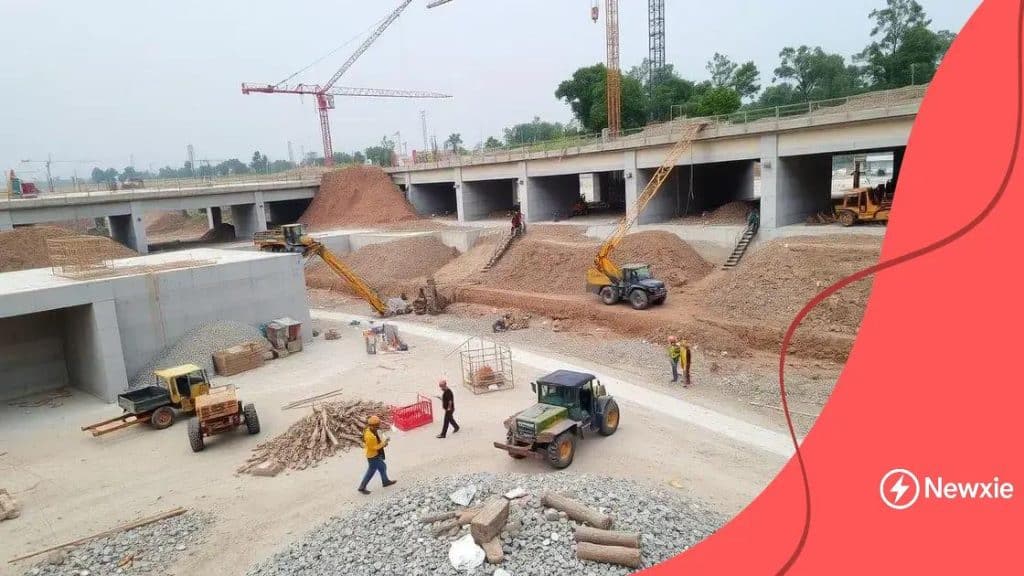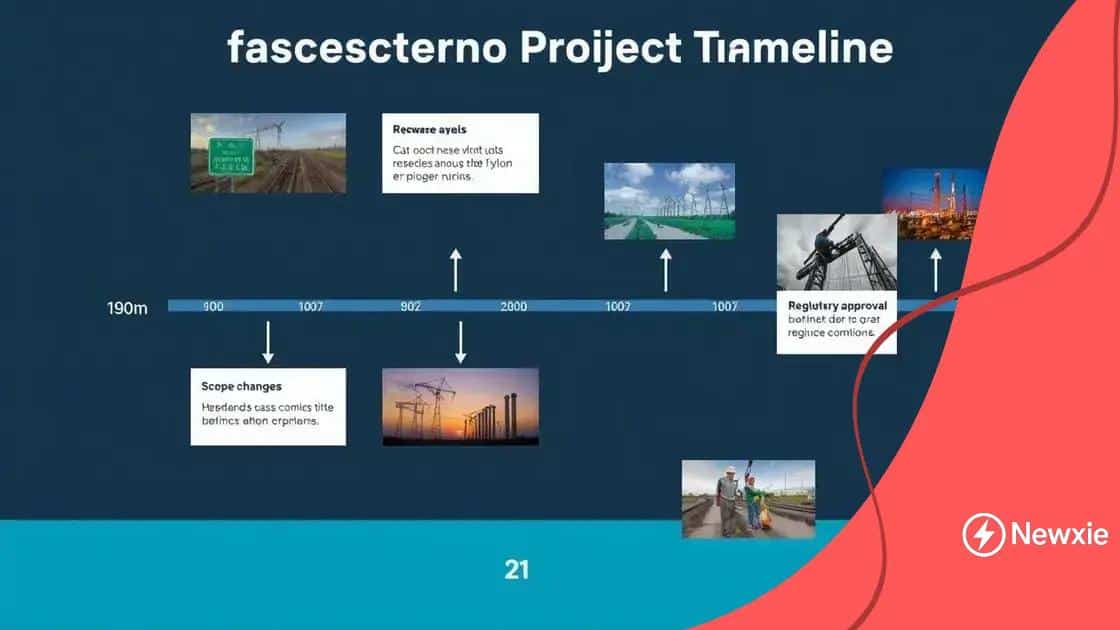Infrastructure project timeline: what to expect and when

Anúncios
Common pitfalls in project planning include poor communication, undefined project scope, ignoring risks, and underestimating time and resources, all of which can derail project success if not managed effectively.
The infrastructure project timeline is crucial for managing expectations and ensuring successful outcomes. Have you ever wondered what really goes into these timelines? In this article, we’ll break down the stages involved and what you can expect.
Anúncios
Understanding infrastructure project timelines
Understanding the infrastructure project timeline is essential for anyone involved in these complex processes. Timelines help keep the project on track and ensure everyone is aware of key milestones. Many factors influence these timelines, from project scope to team efficiency.
Key Components of a Timeline
A well-structured timeline includes several vital components. These components guide the flow of the project and help stakeholders stay informed.
- Project initiation and planning phases
- Development stages and their durations
- Resource allocation periods
- Assessment and review durations
Each phase in an infrastructure project has its own timeline that can be affected by various conditions. Understanding these phases can result in a smoother process. A project usually starts with the initiation phase, which is then followed by planning, where detailed analyses are conducted.
Anúncios
Factors Affecting Timelines
Several factors can impact the timeline significantly. Stakeholders need to consider these challenges early in the planning stage.
- Weather conditions may cause delays.
- Supply chain issues can affect materials availability.
- Regulatory approvals often take longer than expected.
- Unexpected site conditions can complicate timelines.
Timelines also need to be adaptable. Changes in project scope or resources must be incorporated to avoid disruptions. Communication among team members is key here, helping everyone stay informed and aligned with the project’s progress.
In essence, an effective infrastructure project timeline is not just about planning; it’s about ongoing management and adjustments. Keeping an eye on potential disruptions and being proactive can lead projects to achieve their goals more efficiently.
Key phases in infrastructure projects
Key phases in infrastructure projects define the roadmap for successful completion. Understanding these phases makes it easier to manage the entire process. Each phase plays a vital role in ensuring that the project meets its objectives and stays on schedule.
1. Project Initiation
This phase involves defining the project’s purpose and scope. Stakeholders come together to outline their visions. Here, feasibility studies and impact assessments are crucial.
- Identifying stakeholders and their needs
- Assessing initial project costs and budget
- Conducting environmental impact studies
- Formulating a project charter
These steps lay the foundation for the entire project and help everyone understand the goals.
2. Planning and Design
Once the project is initiated, planning follows. This phase includes designing the project and drafting detailed plans. Communication with stakeholders remains essential to align expectations.
- Creating architectural and engineering designs
- Allocating resources and developing timelines
- Conducting technical analyses and risk assessments
- Ensuring permits and legal requirements are met
Accurate planning helps in setting realistic timelines and budgets.
The construction phase is the next critical step. Teams work tirelessly to bring designs to life. Throughout construction, project managers monitor progress closely to ensure adherence to timelines and budgets. Communication continues to flow between all parties involved.
3. Construction
This is where the real work begins. Laborers, engineers, and supervisors collaborate to turn plans into reality. Regular updates are necessary for tracking progress against the project timeline.
- Setting up construction sites and infrastructure
- Implementing safety measures and protocols
- Coordinating material deliveries
- Conducting regular inspections
Effective resource management is crucial during this phase to avoid delays.
4. Monitoring and Control
During construction, monitoring and control are essential. This phase ensures that the project is on track regarding quality and schedule. Adjustments may be needed to address unforeseen challenges.
- Regular progress reports and updates
- Adjusting timelines based on emerging issues
- Maintaining quality control standards
- Budget monitoring to avoid overruns
Finally, project closure involves evaluating the completed work against the initial goals. This phase includes final inspections and handovers, ensuring everything is in order.
Following these key phases in infrastructure projects helps teams stay organized and aligned, leading to successful outcomes. A clear understanding of each phase can significantly impact the project’s success.
Factors affecting project timelines

Several factors play a significant role in shaping project timelines. Understanding these factors is crucial for effective planning and execution. Various elements can influence how long a project will take from start to finish.
1. Resource Availability
The availability of resources is one of the most critical aspects. This includes human resources, materials, and equipment. If any of these resources are lacking, delays are likely to occur.
- Limited workforce can slow progress.
- Material shortages can lead to project hold-ups.
- Equipment breakdowns or unavailability can hinder work.
- Proper scheduling can help mitigate these issues.
Identifying resource requirements during the planning stage helps in preventing delays later on.
2. Weather Conditions
Weather significantly affects outdoor projects. Rain, snow, and extreme temperatures can lead to complications and extended timelines. The unpredictable nature of weather makes it a constant concern throughout the project.
- Heavy rain can halt construction activities.
- Extreme heat may affect worker productivity.
- Snow and ice can create unsafe working conditions.
- Contingency plans can help minimize disruptions.
Being adaptable to varying weather conditions is essential for keeping projects on track.
3. Regulatory Approvals
Many projects require permissions and approvals from local authorities. This bureaucratic process can be slow and complex, affecting the timeline considerably. Delays in getting necessary permits can hinder the start of construction.
- Multiple agencies may need to review and approve plans.
- Changes in regulations can lead to resubmissions.
- Understanding local laws can speed up the process.
- Effective communication with regulatory bodies is essential.
Timely management of these approvals can save precious time and resources.
4. Project Scope Changes
Changes in project scope can also lead to timeline extensions. When stakeholders decide to modify original plans, it often requires additional time for execution.
- Revised designs may require reassessment of project goals.
- Additional stakeholder input can complicate timelines.
- Clear change management processes help address modifications.
- Frequent communication can prevent misunderstandings.
Adjusting timelines proactively when scope changes occur is essential for project success.
By carefully considering these factors affecting project timelines, teams can enhance their planning and management efforts, paving the way for successful project completion.
Best practices for managing timelines
Managing timelines effectively is crucial for the success of any infrastructure project. Following best practices can help teams stay on track and meet their deadlines. By implementing structured approaches, you can enhance your project’s efficiency and productivity.
1. Set Realistic Deadlines
Creating feasible timelines is the first step. Take into account all factors that can affect your project. Avoid underestimating time requirements, as this can lead to stress and poor quality.
- Analyze past projects for better estimates.
- Incorporate buffer time for unforeseen circumstances.
- Consult team members for their input.
- Break larger tasks into smaller, manageable pieces.
By setting realistic deadlines, you create a more achievable framework for success.
2. Use Project Management Tools
Modern technology offers various tools to help manage timelines. These tools enable better communication and facilitate tracking progress.
- Gantt charts visually display project timelines.
- Task management software can help assign responsibilities.
- Collaboration platforms improve team communication.
- Time tracking applications ensure accountability.
Utilizing these tools streamlines project management and enhances efficiency.
3. Regularly Review and Adjust Timelines
Timelines should not be static; they need to evolve as the project progresses. Regular reviews help you stay aware of potential delays or issues.
- Hold frequent team meetings to discuss progress.
- Identify bottlenecks and reallocate resources as needed.
- Adjust timelines based on realistic assessments.
- Communicate changes to all stakeholders promptly.
Keeping everyone informed fosters collaboration and helps maintain project momentum.
4. Maintain Open Communication
Effective communication is essential in managing any timeline. Encourage team members to share updates, challenges, and successes.
- Establish clear reporting protocols.
- Use regular check-ins to monitor progress.
- Encourage feedback for continuous improvement.
- Foster a culture of transparency and trust.
Open lines of communication ensure that all team members are aligned towards common goals.
By integrating these best practices for managing timelines, teams can enhance their productivity and increase the likelihood of project success. A proactive approach gives projects the best chance to stay within their planned timeframe.
Common pitfalls to avoid in project planning
Identifying common pitfalls in project planning can save time and resources. Many projects face similar issues that can derail progress if not addressed early. Awareness of these pitfalls helps teams maintain focus and achieve goals.
1. Poor Communication
One of the most significant barriers to project success is a lack of communication among team members. When team members do not share information, it can lead to misunderstandings and confusion.
- Establish clear communication channels.
- Encourage regular updates and check-ins.
- Use collaborative tools to facilitate discussions.
- Ensure everyone understands their roles and responsibilities.
Effective communication fosters collaboration and ensures everyone is on the same page.
2. Failing to Define Project Scope
Without a clearly defined project scope, it is easy for projects to go off track. A lack of focus can result in wasted resources and time.
- Document all project objectives and deliverables.
- Involve stakeholders in the scope definition process.
- Regularly review scope to prevent scope creep.
- Set boundaries to keep the project manageable.
Defining project scope prevents misunderstandings and helps maintain focus on the project goals.
3. Ignoring Risks
Every project has potential risks that can impact its success. Failing to identify and address risks can lead to major setbacks.
- Conduct a thorough risk assessment at the start.
- Create contingency plans for high-risk factors.
- Regularly review and update the risk management plan.
- Encourage team members to voice concerns.
By actively managing risks, teams can prepare for challenges and avoid disruptions.
4. Underestimating Time and Resources
Another common pitfall is the tendency to underestimate the time and resources needed to complete a project. This can create pressure and lead to compromises in quality.
- Analyze past projects to improve estimation accuracy.
- Involve team members in the estimation process.
- Include buffer time for unexpected challenges.
- Regularly assess progress against timelines.
Accurate estimates promote realistic planning and implementation.
Avoiding these common pitfalls in project planning helps ensure a smoother process and increases the chance of project success. By focusing on communication, clear scope, risk management, and accurate estimates, teams can navigate the planning phase more effectively.
FAQ – Common Pitfalls in Project Planning
What are the main communication barriers in project planning?
Poor communication can lead to misunderstandings and confusion among team members, affecting the overall project outcome.
Why is it important to define project scope?
Defining project scope ensures clarity on objectives and deliverables, preventing scope creep and keeping the project on track.
How can I effectively manage project risks?
Conducting a thorough risk assessment and creating contingency plans can help mitigate potential issues that may arise during the project.
What should I consider when estimating time and resources?
Involve your team in the estimation process and analyze past projects to make accurate time and resource estimates.
SEE MORE CONTENT




